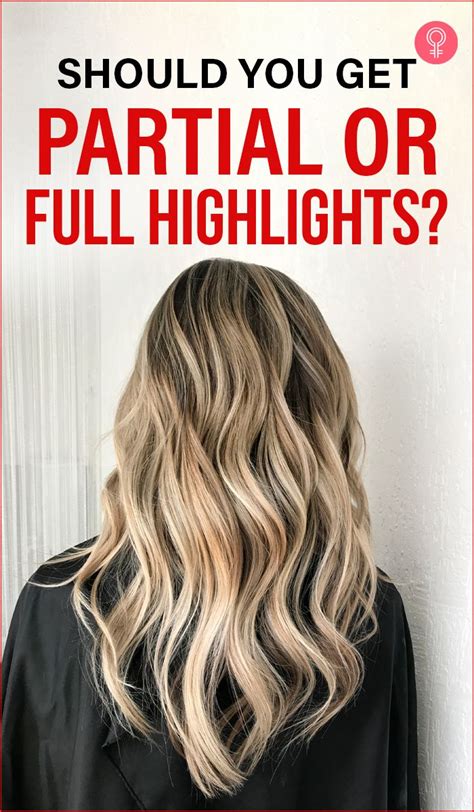Introduction
Highlights are a popular hair-coloring technique that can brighten, enhance, or transform your look. However, there are two main types of highlights: partial and full. Understanding their differences can help you decide which option is best for your hair goals, budget, and lifestyle.

Partial Highlights: Subtle Enhancements
Partial highlights focus on strategically placed streaks of color to accentuate certain areas of your hair. This technique is ideal for those seeking subtle enhancements, such as:
- Concealing gray hairs
- Adding depth and dimension to natural hair
- Creating a sun-kissed effect
- Framing the face with brighter tones
Partial highlights typically involve highlighting 20-50% of the hair, depending on the desired effect. They are usually less time-consuming and costly than full highlights.
Benefits of Partial Highlights
- Natural-looking enhancements
- Less damage to hair
- Lower cost and time commitment
- Ideal for maintaining highlights
Full Highlights: Bold Transformations
Full highlights involve lightening the entire head of hair with evenly distributed color streaks. This technique is recommended for those seeking a more dramatic change, such as:
- Creating a blonde or lighter shade
- Adding vibrancy and brightness
- Covering stubborn gray hair
- Achieving a high-contrast look
Full highlights typically involve highlighting 80-100% of the hair. They are more time-consuming and expensive than partial highlights, and require regular maintenance to prevent fading.
Benefits of Full Highlights
- Dramatic color transformation
- Even distribution of highlights
- Ideal for a complete hair makeover
- Can accommodate more vibrant colors
Comparison Table
| Feature | Partial Highlights | Full Highlights |
|---|---|---|
| Coverage | 20-50% of hair | 80-100% of hair |
| Time commitment | 1-3 hours | 3-6 hours or more |
| Cost | Less expensive | More expensive |
| Naturalness | Subtle enhancements | Bold transformations |
| Maintenance | Minimal touch-ups | Regular touch-ups required |
Which Technique is Right for You?
The best choice between partial and full highlights depends on your individual preferences and hair goals. Consider the following factors:
- Current hair color: If your hair is already light, partial highlights may be sufficient. If it’s dark, full highlights may be necessary.
- Desired effect: Partial highlights offer natural enhancements, while full highlights provide more dramatic transformations.
- Lifestyle: Partial highlights require less maintenance, while full highlights need regular touch-ups.
- Budget: Full highlights are typically more expensive than partial highlights.
Application Techniques
Partial Highlights:
- Using a foil or balayage technique, color is applied to selected sections of hair.
- The width and placement of the streaks can be customized to achieve the desired effect.
- Toner may be used to blend the highlights and create a seamless look.
Full Highlights:
- Color is applied to all sections of the hair, usually using a traditional cap or foil method.
- The thickness and density of the highlights can be adjusted to suit the desired result.
- Toning is often used to achieve an even and cohesive color distribution.
Maintenance and Care
Both partial and full highlights require proper care to maintain their vibrancy and health. Strategies include:
- Regular touch-ups: Partial highlights may require touch-ups every 6-8 weeks, while full highlights may need them every 4-6 weeks.
- Color-protecting shampoo and conditioner: Use products that are specifically designed to protect colored hair.
- Heat protectant: Always use a heat protectant spray before styling with heat tools.
- Avoid chlorine and saltwater: Chlorine and saltwater can strip away color and damage hair. Protect your highlights by using a leave-in conditioner or swim cap.
Side Effects and Risks
All hair-coloring techniques carry some potential risks, including:
- Hair damage: Highlights can damage hair if not applied properly or if the hair is excessively bleached.
- Allergic reactions: Some individuals may experience allergic reactions to hair coloring products. Patch testing is recommended before any highlighting procedure.
- Color fading: Highlights can fade over time, especially if not properly maintained.
Innovations and Trends
The hair industry is constantly evolving, leading to new innovations and trends in highlighting. Some notable developments include:
- Reverse highlights: This technique adds darker streaks to lighten hair, creating a contrasting and edgy look.
- Multi-tonal highlights: Combining different shades of highlights adds depth and dimension to the hair.
- Rainbow highlights: Creating vibrant and colorful highlights using a range of hues is a bold and trendy option.
FAQs
- Are partial highlights less damaging than full highlights? Yes, partial highlights involve less processing and bleach, making them less damaging to the hair.
- Can I highlight my hair at home? While at-home highlighting kits are available, professional results are best achieved in a salon.
- How long do highlights last? Highlights typically last 3-6 months, depending on hair growth and maintenance habits.
- Can I highlight hair that has been previously colored? Yes, but it’s important to consult a stylist to determine the best course of action.
- How much do highlights cost? Partial highlights typically cost $100-$200, while full highlights can range from $200-$400 or more.
- What’s the difference between balayage and foil highlights? Balayage is a freehand technique that creates softer and more natural-looking highlights, while foil highlights provide more precise and defined streaks.
Conclusion
Partial and full highlights offer versatile options for enhancing and transforming your hair. Understanding the differences between these techniques empowers you to make an informed decision that aligns with your personal aesthetic and hair requirements. Whether you prefer subtle accents or a bold makeover, there’s a highlighting technique to suit every style and preference.
